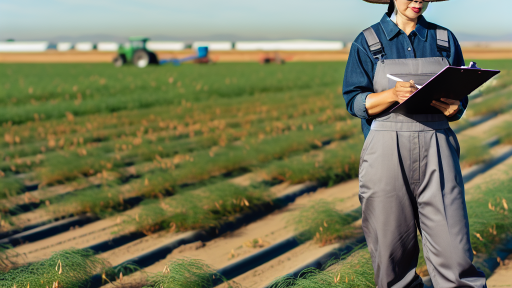Introduction to Agricultural Risk Management
Agricultural risk management is essential for farmers and agribusinesses.
This process helps mitigate potential losses from various uncertainties.
These uncertainties include weather, market fluctuations, and pest infestations.
Effective risk management strategies ensure sustainability and profitability.
Understanding Agricultural Risks
Agricultural risks can be broadly categorized into various types.
Production risks arise from unpredictable factors affecting crop yield.
Market risks relate to price fluctuations for agricultural products.
Financial risks involve the potential for increased borrowing costs.
Environmental risks stem from natural disasters and climate change.
Additionally, operational risks can occur due to management errors.
The Role of Agricultural Insurance
Agricultural insurance provides financial protection against risks.
Farmers can choose from various insurance products to suit their needs.
Crop insurance covers losses from factors like drought and floods.
Livestock insurance protects farmers against animal diseases and mortality.
Moreover, revenue insurance helps stabilize income despite market changes.
Transform Your Agribusiness
Unlock your farm's potential with expert advice tailored to your needs. Get actionable steps that drive real results.
Get StartedBenefits of Insurance Solutions
Insurance solutions offer several key benefits to farmers.
First, they provide peace of mind during uncertain times.
Second, they help secure financing from lenders and investors.
Third, insurance enhances resilience against climate variability.
Furthermore, it supports sustainability by encouraging investment in better practices.
By mitigating risks, insurance fosters long-term agricultural viability.
Importance of Risk Management in Agriculture
Managing agricultural risks is vital in today’s environment.
Farmers must utilize insurance solutions to safeguard their investments.
Robust risk management strategies ensure not only survival but also success.
Types of Agricultural Insurance Products
Crop Insurance
Crop insurance protects farmers against losses due to natural disasters.
This insurance can cover adverse weather conditions like drought or hail.
There are two main types of crop insurance: Actual Production History and Revenue Protection.
Each type has its unique benefits and eligibility requirements.
Farmers often choose crop insurance to secure their income during tough seasons.
Livestock Insurance
Livestock insurance safeguards against the loss of animals due to various risks.
Risks may include disease, accidents, and theft.
This type of insurance can cover cattle, pigs, sheep, and poultry.
Moreover, it may offer options for specific breeds or species.
Farmers often opt for livestock insurance to manage and mitigate financial risks.
Farm Property Insurance
Farm property insurance protects against damage to buildings and equipment.
This insurance typically covers barns, silos, and machinery.
It may also include coverage for tools and supplies used in farming operations.
Farmers can customize their coverage to include specific property needs.
Overall, it provides essential financial protection for farming assets.
Showcase Your Farming Business
Publish your professional farming services profile on our blog for a one-time fee of $200 and reach a dedicated audience of farmers and agribusiness owners.
Publish Your ProfileClimate Risk Insurance
Climate risk insurance addresses risks associated with climate change effects.
For instance, unexpected weather patterns can impact crop yields.
This insurance helps farmers adapt to changes in climate and farming conditions.
Additionally, it provides a safety net for extreme weather events.
This type of insurance is becoming increasingly timely and relevant.
Specialty Crop Insurance
Specialty crop insurance covers specific crops that may not qualify for standard policies.
Crops like fruits, vegetables, and nuts often fall under this category.
This insurance provides tailored coverage that meets unique needs.
Farmers need to understand the specific requirements of specialty crop insurance.
It allows them to secure their investments in diverse agricultural products.
Benefits of Agricultural Insurance for Farmers
Financial Stability
Agricultural insurance helps farmers achieve financial stability.
It safeguards their investments against unpredictable events.
Farmers can focus on their crops without worrying constantly about losses.
Additionally, insurance coverage can help manage debt levels.
Consequently, farmers can maintain their operations during difficult times.
Risk Mitigation
Risk mitigation is crucial in farming.
Agricultural insurance reduces the impact of adverse weather conditions.
Farmers can shield themselves from losses due to droughts or floods.
Moreover, it covers risks related to pests and diseases.
Ultimately, insurance allows farmers to take calculated risks.
Access to Loans
Having agricultural insurance improves access to loans.
Lenders often view insured farmers as lower risk.
This perception leads to better financing options.
Farmers can invest in essential resources and technology.
As a result, they can enhance productivity and sustainability.
Peace of Mind
Insurance provides peace of mind for farmers.
Knowing they are covered against unforeseen events reduces stress.
This mental reassurance contributes to better decision-making.
Farmers can focus on their next steps with confidence.
In addition, this peace of mind fosters a positive community environment.
Encouragement for Innovation
Policyholders often feel encouraged to innovate.
With coverage in place, farmers are more willing to experiment.
This innovation can lead to new farming techniques or crops.
In turn, innovation can improve overall farm efficiency.
Ultimately, this cycle fosters growth within the agricultural sector.
You Might Also Like: Wildlife Conservation Programs In Agriculture
How to Assess Risk in Farming Operations
Understanding Common Risks
Farmers often face multiple risks in their operations.
These risks can stem from weather, pests, and market fluctuations.
For instance, drought can severely impact crop yields.
In addition, disease outbreaks can decimate livestock populations.
Showcase Your Farming Business
Publish your professional farming services profile on our blog for a one-time fee of $200 and reach a dedicated audience of farmers and agribusiness owners.
Publish Your ProfileMarket instability can lead to unpredictable pricing for produce.
Identifying Specific Threats
To effectively assess risk, identify specific threats to your farm.
Consider local weather patterns and their historical impact.
Research prevalent pests and diseases within your region.
Additionally, evaluate potential economic influences affecting pricing.
Collaborate with agricultural extension services for tailored insights.
Utilizing Data and Technology
Modern technology can enhance risk assessment significantly.
Utilizing data analytics helps in predicting potential issues.
Weather forecasting tools provide real-time information to farmers.
Remote sensing technologies can monitor crop health efficiently.
Integrating these tools into your operation is essential for proactive management.
Engaging with Experts
Consulting with agricultural experts can provide valuable perspectives.
These professionals can assist in identifying risk factors.
They also offer advice on best practices for risk mitigation.
Attend workshops or seminars to learn from experienced farmers.
Networking within the agricultural community can foster support and collaboration.
Developing a Risk Management Plan
Creating a comprehensive risk management plan is crucial.
This plan should outline strategies for different risk scenarios.
Include contingency plans for unforeseen events and decision-making processes.
Regularly review and update the plan to reflect changing conditions.
Sharing the plan with your team ensures everyone understands their roles.
Monitoring and Reviewing Risks Regularly
Risk assessment is not a one-time task; it requires ongoing attention.
Regularly monitor changes in weather, markets, and pest outbreaks.
Schedule routine reviews of your risk management plan.
Adapt strategies based on what you learn from these assessments.
Staying informed allows you to respond effectively to new risks.
Discover More: Legal Incentives for Sustainable Agricultural Practices
Selecting the Right Insurance Coverage
Understanding Your Needs
Assessing your unique agricultural needs is crucial.
Identify the specific risks faced by your operation.
Additionally, determine how these risks may impact your yield.
Every farm has different conditions and uncertainties.
Evaluating Insurance Options
Research various types of agricultural insurance products.
Consider options like crop, livestock, and revenue insurance.
Furthermore, look for policies that cover specific hazards.
For example, drought, flood, or pest damage can impact profits.
Comparing Providers
Identify reputable insurance providers in your area.
Review their financial stability and market reputation.
Read customer testimonials to gauge satisfaction levels.
Next, evaluate the variety of plans they offer.
Understanding Terms and Conditions
Read policy documents carefully to understand coverage limits.
Showcase Your Farming Business
Publish your professional farming services profile on our blog for a one-time fee of $200 and reach a dedicated audience of farmers and agribusiness owners.
Publish Your ProfilePay attention to exclusions and specific terms of liability.
Clarify any jargon you do not understand.
A knowledgeable agent can assist with this process.
Cost Considerations
Compare costs of various insurance policies before deciding.
Look for any potential discounts available for bundling options.
Be aware of factors that could affect the cost, like location.
Additionally, assess how premiums relate to your risk levels.
Seeking Professional Advice
Consult with agricultural insurance specialists for guidance.
Expert opinions can provide insights beyond online research.
Moreover, they can help craft a tailored insurance strategy.
Network with other farmers for their recommendations as well.
Delve into the Subject: Essential Coverage Options in Agricultural Insurance

Claims Process for Agricultural Insurance
Initiating the Claims Process
Immediately after an incident, notify your insurance provider.
Provide detailed information about the event.
This includes dates, locations, and damages incurred.
The sooner you report, the better the outcome.
Documentation Requirements
Gather all necessary documents to support your claim.
Documents may include photographs, receipts, and reports.
Accurate documentation is crucial for a successful claim.
Ensure all information is clear and organized.
Assessment of Damages
Your insurance company will assess the reported damages.
An adjuster will visit your property as part of this process.
They will evaluate the extent of the loss firsthand.
Be prepared to answer questions about the situation.
Claim Review Process
After the assessment, your claim enters the review phase.
This is where your insurance provider evaluates all details.
They will determine the coverage based on your policy.
This decision will take time, so stay patient.
Payout and Settlement
Once the review is complete, you will receive a decision.
If approved, the payout will follow soon after.
Understand that the payout depends on the terms of your coverage.
If denied, your provider must explain the reasoning clearly.
Follow-Up Actions
If you have questions, don’t hesitate to reach out.
Clear communication can resolve misunderstandings quickly.
You may also request a reassessment if you disagree with the decision.
Your rights as a policyholder allow for these actions.
See Related Content: Rural Development Policies: A Pathway to Agricultural Prosperity
Government Programs Supporting Agricultural Insurance
Introduction to Agricultural Insurance Programs
Government programs play a crucial role in supporting agricultural insurance.
These initiatives mitigate risks faced by farmers and ranchers.
They help ensure financial stability within the agricultural sector.
Showcase Your Farming Business
Publish your professional farming services profile on our blog for a one-time fee of $200 and reach a dedicated audience of farmers and agribusiness owners.
Publish Your ProfileFederal Crop Insurance Programs
The Federal Crop Insurance Corporation offers protection against crop losses.
Farmers can purchase insurance through approved private companies.
This program provides various coverage options based on individual needs.
Policyholders can receive up to 85% of the value of lost crops.
Moreover, the government subsidizes a portion of the insurance premiums.
Risk Management Agency Initiatives
The Risk Management Agency oversees federal crop insurance and related programs.
It regularly updates policies to meet changing agricultural needs.
Through training and resources, the agency informs farmers about available options.
Additionally, they offer educational programs on risk management strategies.
Enhanced Coverage Options
Some programs provide improved coverage for specialty crops and organic farming.
Reinsured Private Plans can offer customized coverage tailored to unique risks.
These plans may include options for loss of revenue or weather-related damages.
Such flexibility aids in addressing specific market conditions.
Grants and Funding Opportunities
Governments often provide grants to help farmers adopt insurance practices.
These funds may support the initial costs of purchasing crop insurance.
Additionally, organizations like the USDA offer financial assistance programs.
- The Micro Farm Program assists small producers.
- The Non-Insured Crop Disaster Assistance Program aids those without coverage.
- Specialty Crop Block Grant Program focuses on promoting high-value crops.
State-Specific Initiatives
Many states also implement their own agricultural insurance programs.
State agencies may offer supplemental coverages tailored to regional needs.
These programs often complement federal offerings and enhance farmer support.
Farmers should check their state’s resources for additional options.
Future Directions for Agricultural Insurance
Stakeholders continue to advocate for improved government insurance programs.
Efforts may include expanding coverage options and reducing premium costs.
Furthermore, increased outreach can help farmers understand available resources.
Ultimately, enhancing these programs contributes to a robust agricultural sector.
Innovative Trends in Agricultural Insurance Solutions
Introduction to Agricultural Insurance
Agricultural insurance protects farmers against unpredictable risks.
This insurance covers losses due to natural disasters, pests, and diseases.
Increasing volatility in weather patterns necessitates effective insurance solutions.
Usage of Technology in Risk Assessment
Technology significantly shapes agricultural insurance today.
Farmers utilize drones and satellite imagery for accurate crop assessments.
This data allows for better risk evaluation and premium pricing.
Moreover, predictive analytics enhances the understanding of potential threats.
Sustainable Insurance Products
Insurance companies innovate sustainable products to meet environmental needs.
These products encourage sustainable farming practices among policyholders.
Farmers receive incentives for implementing eco-friendly methods.
The result is a mutually beneficial relationship that mitigates risks.
Collaboration with Government Programs
Partnerships with government programs enhance agricultural insurance availability.
Subsidized programs lower the cost for farmers significantly.
These collaborations improve accessibility to vital resources and education.
Farmers benefit from government-backed safety nets in challenging times.
Use of Big Data and AI
Big data and artificial intelligence revolutionize agricultural insurance.
Showcase Your Farming Business
Publish your professional farming services profile on our blog for a one-time fee of $200 and reach a dedicated audience of farmers and agribusiness owners.
Publish Your ProfileThey provide deeper insights into market trends and farmer behavior.
Insurers can tailor products to meet specific individual needs.
This personalization leads to better customer satisfaction and retention.
Microinsurance Options
Microinsurance options are emerging as a popular trend among smallholder farmers.
These products offer affordable coverage for low-income individuals.
This approach promotes inclusivity in agricultural risk management.
Moreover, it enables farmers to recover quickly from losses.
Education and Awareness Programs
Insurance firms invest in education and awareness programs.
These initiatives help farmers understand coverage options better.
Informed farmers make better decisions regarding their insurance needs.
Consequently, they are more likely to secure appropriate coverage.




